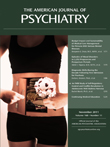The Pathology of Social Phobia Is Independent of Developmental Changes in Face Processing
Abstract
Objective:
While social phobia in adolescence predicts the illness in adulthood, no study has directly compared the neural responses in social phobia in adults and adolescents. The authors examined neural responses to facial expressions in adults and adolescents with social phobia to determine whether the neural correlates of adult social phobia during face processing also manifest in adolescent social phobia.
Method:
Blood-oxygen-level-dependent (BOLD) responses were compared in 39 medication-free participants with social phobia (25 adults and 14 adolescents) and 39 healthy comparison subjects (23 adults and 16 adolescents) matched on age, IQ, and gender. During fMRI scans, participants saw angry, fearful, and neutral expression stimuli while making a gender judgment.
Results:
Significant diagnosis-by-emotion interactions were observed within the amygdala and the rostral anterior cingulate cortex, as has previously been hypothesized. In these regions, both the adolescent and adult social phobia patients showed significantly increased BOLD responses relative to their respective age-matched comparison subjects, and there was no evidence of age-related modulation of between-group differences. These enhanced responses occurred specifically when viewing angry (rostral anterior cingulate cortex) and fearful (amygdala and rostral anterior cingulate cortex) expressions but not when viewing neutral expressions. In addition, the severity of social phobia was significantly correlated with the enhanced rostral anterior cingulate cortex response in the adults.
Conclusions:
The neural correlates of adult social phobia during face processing also manifest in adolescents. Neural correlates that are observed in adult social phobia may represent the persistence of profiles established earlier in life rather than adaptive responses to such earlier perturbations or maturational changes. These cross-sectional observations might encourage longitudinal fMRI studies of adolescent social phobia.



